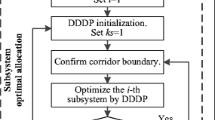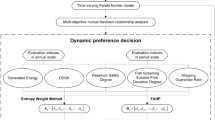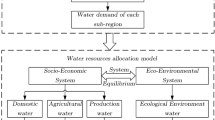Abstract
It is important to manage water resources via emergy theory and its implementation mechanism for water dispatching while considering both economic development and environmental needs. The contribution of this paper is to propose a multi-objective dynamic differential game that can determine the optimal tax rate (OTR), optimal trading quantity of water (OTQW) in each province, and optimal bargain price (OBP) to balance resource consumption, economic development and environmental protection. Considering the sustainability of the ecological environment, the quantification of negative sewage value and net carbon emission constraints are introduced into the water allocation. To maximize the target revenue functions, minimize the net carbon emission constraints and obtain sustainable equilibrium solutions in this triple-level game, the costate function, Hamiltonian, and Lagrangian multiplier method are introduced. Then, a water dispatching structure is constructed for error correction between the predicted and actual runoff of the YRB. Taking the Yellow River Basin as an example, the validity of the proposed framework and solution method were verified under different hydrological years, with 6.5% ~ 9.1% higher economic benefits than other schemes and 4.3% ~ 5.9% lower net carbon emissions than other schemes. Compared to previous studies, this scheme can better meet the requirements of sustainable development and environmental protection.







Similar content being viewed by others
Availability of Data and Materials
The data that support the findings of this study can be found online at http://www.yellowriver.gov.cn/doi.org/10.1016/0165-1889(89)90011-0.
References
Araral E, Wu X (2016) Comparing water resources management in China and India: Policy design, institutional structure and governance. Water Policy 18(S1):1–13
Bagatin R, Klemes JJ, Reverberi AP, Huisingh D (2014) Conservation and improvements in water resource management: a global challenge. J Clean Prod 77(77):1–9
Bajany DM, Zhang L, Xu Y, Xia X (2021) Optimisation approach toward water management and energy security in arid/semiarid regions. Environ Process 8(4):1455–1480
Bekchanov M, Bhaduri A, Ringler C (2015) Potential gains from water rights trading in the Aral Sea Basin. Agr Water Manage 152(6):41–56
Boelens R, Hoogesteger J, Rodriguez JC (2014) Commoditizing water territories: the clash between Andean water rights cultures and payment for environmental services policies. Capital Nat Social 25(3):84–102
Cosgrove WJ, Loucks DP (2015) Water management: Current and future challenges and research directions. Water Resour Res 51(6):4823–4839
Degefu DM, He W, Zhao JH (2017) Transboundary water allocation under water scarce and uncertain conditions: a stochastic bankruptcy approach. Water Policy 19(3):479–495
Ebrahimi A, Rahimi D, Joghataei M, Movahedi S (2021) Correlation wavelet analysis for linkage between winter precipitation and three oceanic sources in Iran. Environ Process 8(3):1027–1045
Green GP, Hamilton JR (2000) Water allocation, transfers and conservation: Links between policy and hydrology. Int J Water Resour D 16(2):197–208
He Y, Chen X, Sheng Z, Lin K, Gui F (2018) Water allocation under the constraint of total water-use quota: a case from Dongjiang River Basin, South China. Hydrolog Sci J 63(1):154–167
Hillman B, Douglas EM, Terkla D (2012) An analysis of the allocation of Yakima River water in terms of sustainability and economic efficiency. J Environ Manag 103:102–112
Huang Z, Liu X, Sun S (2021) Global assessment of future sectoral water scarcity under adaptive inner-basin water allocation measures. Sci Total Environ 783:146973
Janjua S, Hassan I (2020) Use of bankruptcy methods for resolving interprovincial water conflicts over transboundary river: Case study of Indus River in Pakistan. River Res Appl 36(7):1334–1344
Kazemi M, Bozorg HO, Fallah ME, Loáiciga HA (2020) Inter-basin hydropolitics for optimal water resources allocation. Environ Monit Assess 192(7):478
Liu D, Ji X, Tang J, Li H (2020) A fuzzy cooperative game theoretic approach for multinational water resource spatiotemporal allocation. Eur J Oper Res 282(3):1025–1037
Liu J, Li YP, Huang GH, Zeng XT (2014) A dual-interval fixed-mix stochastic programming method for water resources management under uncertainty. Resour Conserv Recycl 88:50–66
Medeiros DF, Urtiga MM, Morais DC (2017) Integrative negotiation model to support water resources management. J Clean Prod 150:148–163
Nicklow J, Reed P, Savic D, Dessalegne T, Harrell L, Chan A (2010) State of the art for genetic algorithms and beyond in water resources planning and management. J Water Res Plan Manag 136(4):412–432
Qin XS, Huang GH, Zeng GM, Chakma A, Huang YF (2012) A linear-parameter fuzzy nonlinear optimization model for stream water quality management under uncertainty. Eur J Oper Res 180:1331–1357
Shen C (2018) A transdisciplinary review of deep learning research and its relevance for water resources scientists. Water Resour Res 54(11):8558–8593
Shen X, Wu X, Xie X, Wei C, Li L, Zhang J (2021) Synergetic theory-based water resource allocation model. Water Resour Manag 35(7):2053–2078
Suo MQ, Li YP, Huang GH, Deng DL, Li YF (2013) Electric power system planning under uncertainty using inexact inventory nonlinear programming method. J Environ Inform 22(1):49–67
Tayfur G (2017) Modern optimization methods in water resources planning, engineering and management. Water Resour Manag 31(10):3205–3233
Wang T, Zhang J, Li Y (2022) Optimal design of two-dimensional water trading based on risk aversion for sustainable development of Daguhe watershed, China. J Environ Manage 309:114679
Wang Y, Peng SM, Wu J (2019) Review of the implementation of the Yellow River water allocation scheme for thirty years. Yellow River 41(9):6–9
Xu J, Lv C, Yao L, Hou S (2019) Intergenerational equity based optimal water allocation for sustainable development: a case study on the upper reaches of Minjiang River, China. J Hydrol 568:835–848
Yeh WW, Becker L, Hua S, Wen D, Liu J (1992) Optimization of real-time hydrothermal system operation. J Water Res Plan Man 118(6):636–653
Zhao B, Ren Y, Gao D, Xu L (2019) Performance ratio prediction of photovoltaic pumping system based on grey clustering and second curvelet neural network. Energy 171:360–371
Zheng Y, Sang X, Liu Z, Zhang S, Liu P (2022) Water allocation management under scarcity: a bankruptcy approach. Water Resour Manag 36(9):2891–2912
Funding
This research was supported by the National Natural Science Foundation of China (52109039) and the Key Scientific Research Project plan of Henan Province (22A570008).
Author information
Authors and Affiliations
Contributions
Conceptualization & methodology, D.D. and Z.W.; methodology, Q.S.; software, D.D. and Z.W.; validation, D.D.; data curation, D.D. and Z.W.; writing—original draft preparation, D.D.; writing—review and editing, H.W..
Corresponding author
Ethics declarations
Ethics Approval
N/A.
Consent to Participate
N/A.
Consent to Publish
N/A.
Competing Interests
The authors declare that there are no financial or non-financial competing interests related to this article. The authors declare that they have no known competing financial interests or personal relationships that could have appeared to influence the work reported in this paper.
Additional information
Publisher's Note
Springer Nature remains neutral with regard to jurisdictional claims in published maps and institutional affiliations.
Rights and permissions
Springer Nature or its licensor holds exclusive rights to this article under a publishing agreement with the author(s) or other rightsholder(s); author self-archiving of the accepted manuscript version of this article is solely governed by the terms of such publishing agreement and applicable law.
About this article
Cite this article
Di, D., Shi, Q., Wu, Z. et al. Sustainable Management and Environmental Protection for Basin Water Allocation: Differential Game-based Multiobjective Programming. Water Resour Manage 37, 1–20 (2023). https://doi.org/10.1007/s11269-022-03351-6
Received:
Accepted:
Published:
Issue Date:
DOI: https://doi.org/10.1007/s11269-022-03351-6




